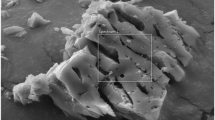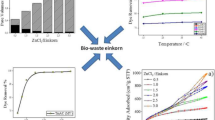Abstract
This paper compares the effectiveness of activated carbon prepared by khat and neem leaves in treating the wastewater collected from automobile service stations. Wastewater was collected from service stations in the Haramaya city of Ethiopia. Proximate analysis of different leaves, such as khat, neem and gudhal, was tested, and the fixed carbon percentage is 81, 78 and 72, respectively. On the basis of high percentage of fixed carbon, khat and neem activated carbon are selected for further study. Zinc chloride is used for activation, and the samples khat and neem activated carbon are characterized by X-ray diffraction, scanning electron microscopy, thermo-gravimetric analysis and Fourier transform infrared spectroscopy. The turbidity and pH of wastewater was tested before and after the treatment. In the case of khat activated carbon, turbidity was reduced up to 30 mg/lit and the combination of khat and neem activated carbon removed up to 15 mg/lit. In both the cases, khat activated carbon is effective in neutralizing pH and reducing turbidity.







Similar content being viewed by others

References
Ahmaruzzaman, M., & Laxmi Gayatri, S. (2010). Batch adsorption of 4-nitrophenol by acid activated jute stick char: Equilibrium, kinetic and thermodynamic studies. Chemical Engineering Journal,158(2), 173–180. https://doi.org/10.1016/j.cej.2009.12.027.
Algabr, M. N., Al-Wadhaf, H. A., Ameddah, S., Menad, A., Mekkiou, R., Chalchat, J. C., et al. (2014). Analysis of the essential oil of leaves Catha edulis from Yemen. International Journal of Applied Research in Natural Products,7(2), 21–24.
Allen, S., & Koumanova, B. (2005). Decolourisation of water/wastewater using adsorption. Journal of the University of Chemical Technology and Metallurgy,40(3), 175–192.
Celine, S., Tomy, S., Ujwala, T. K., Johnson, S., & Chander, U. (2016). A detailed overview of medicinal plants having hypoglycemic activity. International Journal of Phytomedicine,8(2), 139–175.
Debabrata, M., & Somnath, M. (2011). Treatment of automobile service station wastewater by coagulation and activated sludge process. International Journal of Environmental Science and Development,2(1), 64–69.
Elkady, M. F., Hussein, M. M., & Salama, M. M. (2015). Synthesis and characterization of nano-activated carbon from el maghara coal, Sinai, Egypt to be utilized for wastewater purification. American Journal of Applied Chemistry,3(3–1), 1–7. https://doi.org/10.11648/j.ajac.s.2015030301.11.
Girgis, B. S., Temerk, Y. M., Gadelrab, M. M., & Abdullah, I. D. (2007). X-ray diffraction patterns of activated carbons prepared under various conditions. Carbon Science,8(2), 95–100. https://doi.org/10.5714/CL.2007.8.2.095.
Hossain, M. A., Al-Toubi, Wafa A. S., Weli, A. M., Al-Riyami, Q. A., & Al-Sabahi, J. N. (2013). Identification and characterization of chemical compounds in different crude extracts from leaves of Omani neem. Journal of Taibah University for Science,7(4), 181–188.
Ibrahim, M. B., & Sani, S. (2015). Neem (Azadirachta indica) leaves for removal of organic pollutants. Journal of Geoscience and Environment Protection,3(2), 1–9.
Kenneth, A., Gimba, C., Kagbu, J. A., & Nale, B. Y. (2010). Preparation of activated carbon from neem (Azadirachta indica) husk by chemical activation with H3PO4, KOH and ZnCl2. Archives of Applied Science Research,2(5), 451–455.
Krizevski, R., Dudai, N., Bar, E., & Lewinsohn, E. (2007). Developmental patterns of phenylpropylamino alkaloids accumulation in khat (Catha edulis, Forsk.). [Research Support, Non-U S Gov’t]. Journal of Ethnopharmacology,114(3), 432–438.
Kumari, A. V. A. G., Palavesam, A., Sunilson, J. A. J., Anandarajagopal, K., Vignesh, M., & Parkavi, J. (2010). Preliminary phytochemical and antiulcer studies of Hibiscus rosa sinensis Linn. root extracts. International Journal of Green Pharmacy,4(1), 41–43.
Li, H.-B., Zhang, J., Wu, Y., Jin, J.-L., Duan, Y.-A., Su, Z.-M., et al. (2014). Theoretical study and design of triphenylamine-malononitrile-based p-type organic dyes with different π-linkers for dyes-sensitized solar cells. Dyes and Pigments,108(Supplement C), 106–114. https://doi.org/10.1016/j.dyepig.2014.04.029.
Maitera, O. N., Osemeahon, S. A., & Barnabas, H. L. (2014). Proximate and elemental analysis of avocado fruit obtained from Taraba State, Nigeria. Indian Journal of Scientific Research and Technology,2(2), 67–73.
Malik, D. S., Jain, C. K., & Yadav, A. K. (2017). Removal of heavy metals from emerging cellulosic low-cost adsorbents: a review. Applied Water Science,7(5), 2113–2136. https://doi.org/10.1007/s13201-016-0401-8.
Mazumder, D., & Mukherjee, S. (2011). Treatment of automobile service station wastewater by coagulation and activated sludge process. International Journal of Environmental Science and Development,2(1), 64–69. https://doi.org/10.7763/ijesd.2011.v2.98.
Mostafa, N. M., Eldahshan, O. A., & Singab, A. N. B. (2015). Chemical composition and antimicrobial activity of flower essential oil of Jacaranda acutifolia Juss. against food-borne pathogens. European Journal of Medicinal Plants,6(2), 62–69.
Muluh, S. N., Ghogomu, J. N., Alongamo, A. A. B., & Ajifack, D. L. (2017). Adsorption of phenol from aqueous solution by avocado seed activated carbon: Equilibrium, kinetic, and full factorial design analysis. International Journal of Advanced Engineering Research and Technology,5(8), 610–620.
Obikaonu, H. O., & Udedible, A. B. I. (2015). Evaluation of neem (Azadirachta indica) leaf meal in the diets of black leghorn laying hens for protein sustaininability and national development. International Journal of Agricultural Technology,11(5), 1089–1095.
Prahas, D., Kartika, Y., Indraswati, N., & Ismadji, S. (2008). Activated carbon from jackfruit peel waste by H3PO4 chemical activation: Pore structure and surface chemistry characterization. Chemical Engineering Journal,140(1), 32–42. https://doi.org/10.1016/j.cej.2007.08.032.
Shimizu, N., Tomoda, M., Suzuki, I., & Takada, K. (1993). Plant mucilages. XLIII. A representative mucilage with biological activity from the leaves of Hibiscus rosa-sinensis. Biological &/and Pharmaceutical Bulletin,16(8), 735–739.
Venkateswarlu, P., Venkata Ratnam, M., Subba Rao, D., & Venkateswara Rao, M. (2007). Removal of chromium from an aqueous solution using Azadirachta indica (neem) leaf powder as an adsorbent. International Journal of Physical Sciences,2(8), 188–195.
Vijayakumar, S., Arunprakash, C., Sivakumar, V., Shidhardhan, C. K., Gobinath, R., & Shobana, K. S. (2014). Preliminary adsorption studies on textile industry waste water using Neem leaf powder as an adsorbant. International Journal of Applied Sciences and Engineering Research,3(1), 105–110.
Xu, J., Chen, L., & Feng, X. (2014). Preparation and characterization of activated carbon from reedy grass leaves in a two-step activation procedure. In International conference on material and environmental engineering, 2014 (pp. 99–102). https://doi.org/10.4028/www.scientific.net/AMR.881-883.579.
Acknowledgements
The authors are thankful to Haramaya University and the University of Nizwa for providing the infrastructure to carry out the research work.
Author information
Authors and Affiliations
Corresponding author
Additional information
Publisher's Note
Springer Nature remains neutral with regard to jurisdictional claims in published maps and institutional affiliations.
Rights and permissions
About this article
Cite this article
Kumari, S., Annamareddy, S.H.K. Treatment of garage wastewater using activated carbon made from khat (Catha edulis) and neem (Azadirachta indica) leaves. Environ Dev Sustain 22, 2967–2978 (2020). https://doi.org/10.1007/s10668-019-00330-7
Received:
Accepted:
Published:
Issue Date:
DOI: https://doi.org/10.1007/s10668-019-00330-7



